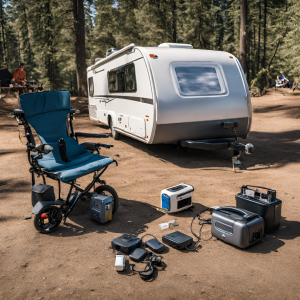Charging Mobility Scooters and Medical Devices in an RV with Jackery

If you're an RV traveler who relies on a mobility scooter or other medical device, you know how important it is to keep these devices charged and ready to go. When you're on the road, you need a reliable power source that can keep up with your needs. That's where Jackery comes in. With their line of portable power stations, you can charge your mobility scooter or medical device no matter where you are.
Understanding charging in an RV is key to ensuring that your mobility scooter or medical device is always ready when you need it. RVs have different power systems than traditional homes, so it's important to know what you're working with. Jackery charging solutions are designed to work with RVs, and they offer a range of products that can meet your needs.
Charging mobility scooters and medical devices in an RV with Jackery is simple and straightforward. With the right equipment and a few practical tips, you can keep your devices charged and ready to go. In this article, we'll take a closer look at how to do just that, so you can travel with confidence and peace of mind.
Key Takeaways
- Jackery's line of portable power stations is a reliable power source for charging mobility scooters and medical devices in an RV.
- Understanding charging in an RV is key to ensuring that your devices are always ready when you need them.
- With the right equipment and practical tips, you can keep your mobility scooter or medical device charged and ready to go while on the road.
Understanding Charging in an RV
When it comes to charging mobility scooters and medical devices in an RV, it's important to understand the basics of RV electrical systems, the types of batteries used in RVs, and an overview of Jackery portable power stations.
Basics of RV Electrical Systems
RVs are equipped with electrical systems that allow you to use appliances and charge devices while on the go. These electrical systems typically include a battery, an inverter, and a converter. The battery is used to store power, while the inverter converts DC power from the battery to AC power that can be used to power appliances. The converter is used to convert AC power from an external power source, such as a campground hookup, to DC power that can be used to charge the battery.
Types of Batteries Used in RVs
There are several types of batteries used in RVs, including lead-acid, AGM, and lithium-ion batteries. Lead-acid batteries are the most common type of battery used in RVs and are relatively inexpensive. AGM batteries are a type of lead-acid battery that is sealed and maintenance-free. Lithium-ion batteries are more expensive but offer longer life and faster charging times.
Overview of Jackery Portable Power Stations
Jackery offers a range of portable power stations that can be used to charge mobility scooters and medical devices in an RV. The Explorer 1000 is a popular option that offers 1000W of power and can charge a mobility scooter or medical device multiple times. The Solar Generator 2000 Pro and Solar Generator 3000 Pro are also good options that offer even more power. The Explorer 1500 and Explorer 1000 Pro are smaller and more affordable options that are perfect for charging smaller devices.
Understanding the basics of RV electrical systems, the types of batteries used in RVs, and an overview of Jackery portable power stations is important when it comes to charging mobility scooters and medical devices in an RV. By using a reliable power source such as a Jackery power station, you can ensure that your devices are always charged and ready to go.
Charging Mobility Scooters and Medical Devices
If you're planning to travel in an RV with your mobility scooter or medical device, you'll need to ensure that you can charge them safely and effectively. Here are some tips to help you charge your devices while on the road.
Safety Considerations for Charging
Before you start charging your mobility scooter or medical device, it's important to consider some safety factors. Make sure that you're in a well-ventilated area, away from any flammable materials if you are using a gas generator. Ensure that the charger, charging port, adapter, and power outlet are all in good condition and free from any damage. Always read the manufacturer's instructions before charging your batteries, and never attempt to modify or repair the charger or battery yourself.
Adapting Chargers for RV Use
One of the challenges of charging mobility scooters and medical devices in an RV is that the power supply may not be compatible with the charger. You may need to use an adapter or converter to ensure that the charger can be used safely with the RV's power supply. Some chargers may also require a higher voltage or amperage than the RV's power supply can provide. In these cases, you may need to invest in a more powerful charger that can handle the higher voltage or amperage.
Maintaining Battery Health
To ensure that your mobility scooter or medical device battery lasts as long as possible, you should take steps to maintain its health. This includes regularly charging the battery, but also avoiding overcharging or undercharging it. Overcharging can cause the battery to become hot and potentially explode, while undercharging can reduce the battery's capacity and longevity. You should also ensure that the battery is stored in a cool, dry place when not in use, and avoid exposing it to extreme temperatures or moisture.
By following these tips, you can ensure that your mobility scooter or medical device is safely and effectively charged while on the road.
Jackery Charging Solutions
If you're looking for a reliable and efficient way to charge your mobility scooters and medical devices while on the road, Jackery has a range of portable power stations that can meet your needs. Here are some things to consider when selecting the right Jackery model for your RV.
Selecting the Right Jackery Model
Jackery offers several models of portable power stations, each with different capacities and specifications. The Jackery Explorer 1000 is a popular choice for RVers, with a 1002Wh capacity and multiple output options including AC, DC, and USB. If you need even more power, the Jackery Solar Generator 2000 Pro and 3000 Pro offer 2000Wh and 3075Wh capacities respectively, with similar output options.
Using Jackery Solar Generators for Charging
One of the most convenient ways to recharge your Jackery portable power station is with solar power. Jackery offers their own line of SolarSaga solar panels, which are designed to work seamlessly with their power stations. The SolarSaga 100W panel can fully recharge the Explorer 1000 in 8 hours, while two SolarSaga 100W panels can fully recharge the Solar Generator 2000 Pro in 6-7 hours.
Maximizing Charging Efficiency
To get the most out of your Jackery portable power station, it's important to maximize charging efficiency. Here are some tips to help you do just that:
- Use solar panels whenever possible to recharge your power station.
- Keep your solar panels clean and free of debris to ensure maximum output.
- Monitor your power station's battery level with the built-in battery monitor to avoid overcharging or draining the battery.
- Optimize your charging times by charging during peak sunlight hours and avoiding charging during cloudy or overcast days.
By following these tips and selecting the right Jackery model for your needs, you can enjoy reliable and efficient charging for your mobility scooters and medical devices while on the road.
Practical Charging Tips
When it comes to charging mobility scooters and medical devices in an RV, it's essential to have a reliable and powerful power source. Jackery is an excellent choice for powering your devices while on the road. Here are some practical charging tips to help you get the most out of your Jackery power station.
Optimizing Charging Time and Power Usage
To optimize your charging time and power usage, it's essential to understand the charging process. Always read the manufacturer's instructions before charging your devices. Make sure that the charger you are using is compatible with your device type. Connect the charger to the device before plugging it into the power outlet. This will help prevent any damage to the device or the charger.
When charging your devices, it's essential to avoid overcharging. Overcharging can damage the battery and reduce its lifespan. Always monitor the charging process and unplug the charger once the battery is fully charged.
Connecting Multiple Devices
Jackery power stations come with multiple ports that allow you to charge multiple devices simultaneously. However, it's essential to avoid overloading the power station. Check the power requirements of each device before connecting it to the power station. This will help prevent any damage to the devices or the power station.
Using Jackery for Off-Grid Adventures
One of the benefits of using Jackery for charging your devices is its portability. Jackery power stations are lightweight and easy to carry, making them an excellent choice for off-grid adventures. You can use Jackery to power your laptop, phone, TV, microwave, and other appliances while camping.
Jackery power stations are also environmentally friendly. They use renewable energy sources, such as solar panels, to charge the battery. This makes them an excellent choice for anyone looking to reduce their carbon footprint.
In conclusion, Jackery is an excellent choice for charging mobility scooters and medical devices in an RV. By following these practical charging tips, you can optimize your charging time and power usage, connect multiple devices, and use Jackery for off-grid adventures.
Additional Considerations
When it comes to charging your mobility scooter or medical device in an RV using a Jackery unit, there are a few additional considerations to keep in mind. These include understanding charging indicators and controls, dealing with power surges and interruptions, and properly maintaining and storing your Jackery unit.
Understanding Charging Indicators and Controls
To ensure that your device is charging properly, it is important to understand the charging indicators and controls on your Jackery unit. Refer to the user manual for specific instructions on how to operate your unit. Make sure that the charge controller is set correctly for your device's battery type and voltage.
Dealing with Power Surges and Interruptions
Power surges or interruptions can damage your device's battery or cause it to stop charging. To prevent this, consider using a surge protector or circuit breaker between your Jackery unit and the device. If you experience a power interruption, make sure to unplug your device and wait for the power to return before reconnecting it to the Jackery unit.
Maintenance and Storage of Jackery Units
To ensure that your Jackery unit remains in good condition and operates efficiently, it is important to properly maintain and store it. Keep your unit clean and well-ventilated to prevent overheating. Regularly check the battery level and charge it as needed. If you plan on storing your unit for an extended period of time, make sure to charge it fully and disconnect any devices before storing it in a cool, dry place.
By following these additional considerations, you can ensure that your mobility scooter or medical device is charged safely and efficiently using a Jackery unit in your RV.
Accessories and Enhancements
If you're planning on traveling with your medical devices in an RV, you'll need to ensure that you have enough power to keep them charged and ready to use. Jackery offers a range of accessories and enhancements that can help you expand your battery capacity and extend your charging capabilities.
Expanding Capacity with Additional Batteries
One of the easiest ways to increase your battery capacity is to add additional batteries to your setup. Jackery offers a range of lithium batteries that are designed to work seamlessly with their portable power stations. These batteries are lightweight, compact, and can be easily connected to your existing setup.
Solar Panel Add-Ons for Extended Charging
If you're planning on spending a lot of time off the grid, you may want to consider adding a solar panel to your setup. Jackery offers a range of solar panel add-ons that can help you extend your charging capabilities and keep your medical devices powered up and ready to use.
Upgrading for Specific Needs
Depending on your specific needs, you may want to consider upgrading your setup to better accommodate your medical devices. For example, if you rely on a CPAP machine, you may want to invest in a more powerful battery that can provide enough power to keep your machine running all night. Similarly, if you need to charge multiple devices at once, you may want to consider upgrading to a larger portable power station that can handle the additional load.
Overall, Jackery offers a range of accessories and enhancements that can help you keep your medical devices powered up and ready to use while on the road. With the right setup, you can enjoy all the freedom and flexibility of RV travel without having to worry about running out of power.
Frequently Asked Questions
How do I safely charge my mobility scooter or medical device using a Jackery in an RV?
To safely charge your mobility scooter or medical device using a Jackery in an RV, you should follow these steps:
- Ensure that the Jackery power station is fully charged before use.
- Connect the Jackery power station to your mobility scooter or medical device using the appropriate charging cable.
- Turn on the Jackery power station and wait for your device to charge fully.
- Always keep an eye on the charging process to ensure that your device is not overcharging or overheating.
What is the best way to connect a solar generator to an RV for charging devices?
The best way to connect a solar generator to an RV for charging devices is to use a solar panel kit. This will allow you to harness the power of the sun to charge your devices while on the move. You can also connect your solar generator to your RV's battery bank using an appropriate charging cable.
Can a Jackery power station be used continuously while it's charging?
Yes, a Jackery power station can be used continuously while it's charging. This is because the power station is designed to charge and discharge at the same time. However, it's important to note that the charging time may be longer when the power station is being used at the same time.
Is it possible to charge a vehicle battery with a portable Jackery unit?
Yes, it is possible to charge a vehicle battery with a portable Jackery unit. However, you will need to use an appropriate charging cable and ensure that the Jackery unit has enough power to charge the battery fully.
What are the steps to follow when using an Allto solar charge controller with a Jackery?
When using an Allto solar charge controller with a Jackery, you should follow these steps:
- Connect the solar panel to the Allto solar charge controller.
- Connect the Allto solar charge controller to the Jackery power station using an appropriate charging cable.
- Turn on the Jackery power station and the Allto solar charge controller.
- Wait for the Jackery power station to charge fully.
How can I ensure my Jackery power station is efficiently charged using solar panels while on the move?
To ensure that your Jackery power station is efficiently charged using solar panels while on the move, you should follow these steps:
- Position your solar panels in a location where they will receive maximum sunlight.
- Use an appropriate charging cable to connect your solar panels to your Jackery power station.
- Monitor the charging process to ensure that your power station is charging efficiently.
- Consider investing in a solar panel kit that is specifically designed for use with your Jackery power station.
Related articles for Charging mobility scooters and medical devices in an RV with Jackery
Jackery for Off Grid Cabin
Jackery Campervan Features
Jackery for RV Appliances
1000 Pro for Off-Grid Events
Jackery Off-Grid Solar
Jackery Family Living Off-Grid
Silent Off-Grid Jackery
Major Off-Grid Appliances
Calculate Off-Grid Runtimes



